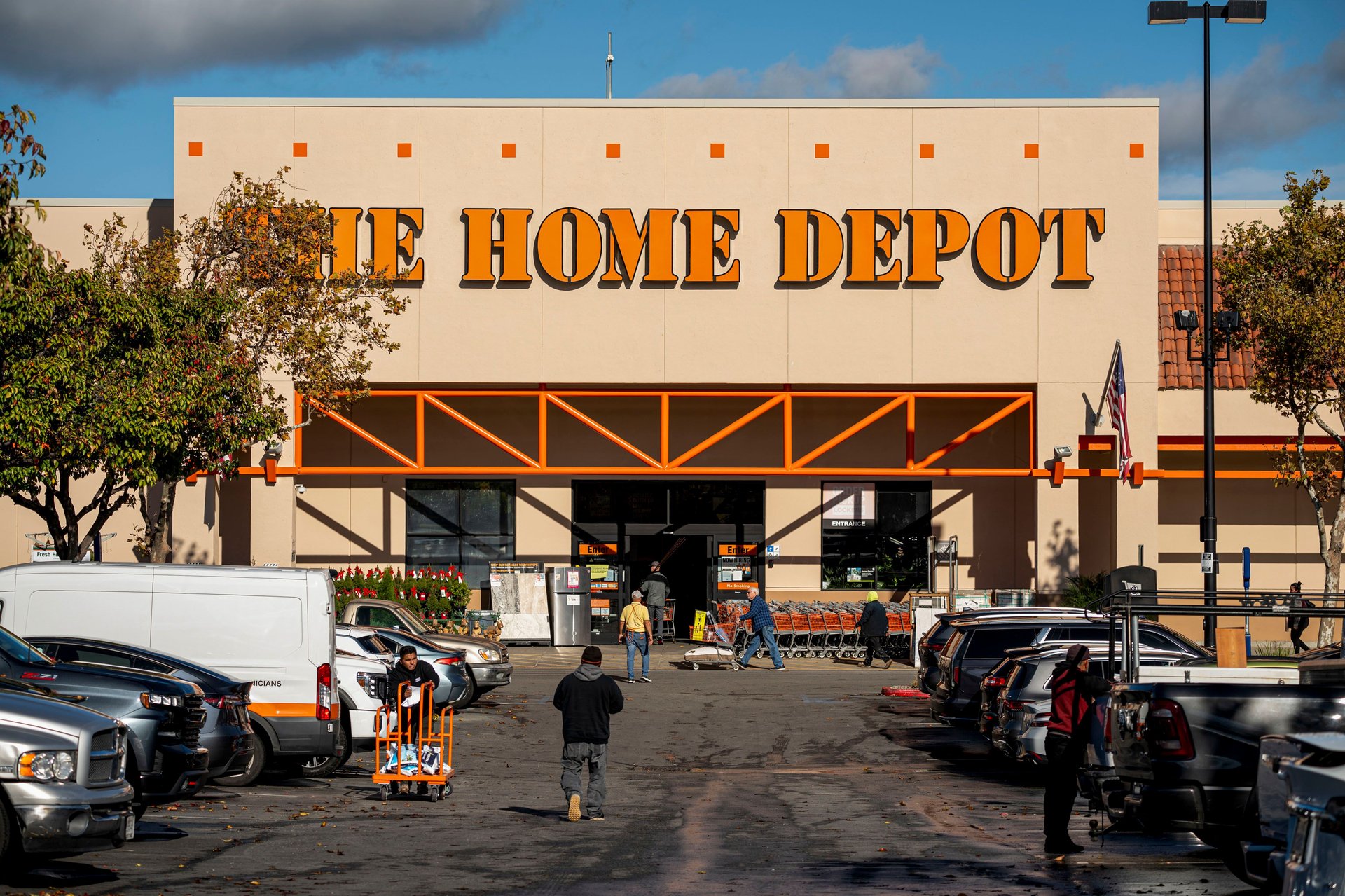Home Depot steadies guidance as big projects stall
Big-ticket remodels slowed, traffic dipped, and tariffs loomed — but Home Depot held its guidance and showed just enough promise to send shares up 4%

David Paul Morris/Bloomberg via Getty Images
Home Depot’s second quarter was less a finished project than a work still under construction — patched with smaller jobs, steady pricing, and Wall Street’s optimism for what comes next.
Suggested Reading
The results themselves were hardly flawless. Revenue came in at $45.3 billion and adjusted earnings per share at $4.68, both just shy of Wall Street’s forecasts. Big-ticket sales, long a driver of Home Depot’s growth, remained weak as consumers pulled back from kitchen remodels and bath overhauls. Foot traffic slipped about 2%, according to Placer.ai, underscoring the caution hanging over the housing and home-improvement markets.
Related Content
But the real narrative might not be in what the company missed but in how it held firm. This quarter was largely steadied by management’s decision to hold guidance. Home Depot reaffirmed its forecast for 2025, calling for 2.8% sales growth and a 2% decline in EPS, signaling confidence amid economic fog. That was enough to keep the Street calm, even if it wasn’t a sign of acceleration.
Shares rose about 1% in premarket trading and were up 4% around 10 a.m. ET, lifted more by the reassurance of stability than the substance of the numbers.
Any kind of restraint matters in today’s volatile mix of inflation, trade policy, and shifting consumer behavior. And Wall Street is responding positively to a quarter from Home Depot that somewhat signals discipline, not desperation — steady pricing amid a tariff-heavy backdrop and a credible lift from repair-and-maintenance work.
The analyst at Stifel raised the price target to $432 while maintaining a “Buy” rating, and DA Davidson also reiterated a “Buy” rating with a $450 target, pointing to resilient core demand and optimism around rate relief. Analysts have also underscored Home Depot’s stronger foothold in the professional contractor space, noting that its broader reach into its “Pro” channels leaves the company better positioned than some of its more DIY‑dependent peers heading into what seems to be a cooling housing environment.
“The improvement through the quarter and reaffirmed annual guidance, as well as Home Depot not needing to raise prices despite the current elevated tariff environment, are encouraging,” Telsey Advisory Group analyst Joseph Feldman wrote in a note seen by Reuters.
Pricing discipline has become the company’s storyline. Home Depot executives said the company was able to largely hold the line on prices in the second quarter despite President Donald Trump’s tariff-heavy economic backdrop, thanks in part to the company’s supply chain mix. The company said last quarter that more than half of Home Depot’s inventory is sourced domestically, and no single foreign country contributes more than 10% of its assortment. Last quarter, when asked about how Trump’s tariffs would affect the company’s pricing plans, Home Depot said it wouldn’t speculate — but that tariffs could lead it to no longer offering certain items.
Tuesday, in a separate, later interview with the Wall Street Journal (and confirmed to CNN), chief financial officer Richard McPhail acknowledged that some imported goods now face sharply higher tariff rates and said there would be “modest price movement in some categories.” For a company that has built part of its pitch on pricing restraint, that caveat looms large.
Consumers have largely shelved the marquee remodels — kitchens, baths, full-scale gut jobs — that once powered Home Depot’s biggest gains. Instead, they’re gravitating toward smaller, more manageable projects: repainting walls, plastering cracks, swapping out fixtures. That pivot has been enough to keep the sales line moving. U.S. comparable sales rose 1.4% in the second quarter, the third straight quarterly gain, with July delivering an extra lift from a delayed spring. These patch-and-paint jobs don’t carry the same ticket size as a full renovation — analysts have said the company’s softness in larger projects remains a risk — but in a high-rate environment, they’re proving to be the kind of resilient spending that keeps aisles busy.
At the same time, Home Depot is leaning more heavily on its professional contractor base, which has become a stable counterweight to softer DIY demand. Pros still need roofing, lumber, and bulk orders to keep their businesses moving even when homeowners step back from ambitious remodels. That segment has grown into a strategic hinge, giving Home Depot a sturdier foundation than some of its peers, where exposure tilts more toward the weekend project crowd.
Together, the steady drip of DIY repairs and the ongoing pull from Pro customers are helping Home Depot patch over some of the weakness in big-ticket categories — enough, at least, to keep its comps streak alive. And the fact that shoppers are spending more per trip, averaging about $90, helps blunt the effect of fewer visits and keeps the top line moving upward.
That balancing act — steady guidance, careful pricing, and uneven demand — largely defined the quarter.
Home Depot serves as this earnings season’s retail bellwether, so its mix of guidance and strategy will be read as a litmus test for the rest of the industry. If consumers are still willing to open their wallets for paint and lumber, even as they shy away from full remodels, then the broader retail sector may not be as brittle as feared. But the quarter also underlines how fragile that demand is — and how tariffs, rates, and a cooling housing market could quickly shift the foundation.
Investors are already mapping Home Depot’s read-through onto expectations for Walmart, Target, and others.
This quarter seems less like a blockbuster and more about structural integrity. Home Depot isn’t building cathedrals right now. It’s reinforcing the foundation — maintaining pricing, pivoting toward modest project demand, and holding guidance steady. It’s drywall, not marble. Patch jobs, not palaces. That may reassure investors in the short term, but it’s also a reminder that the house isn’t finished.
